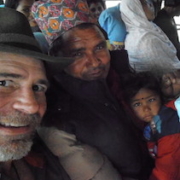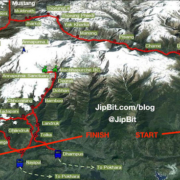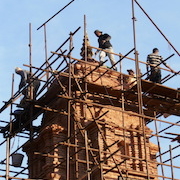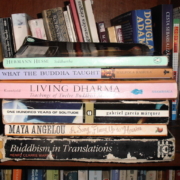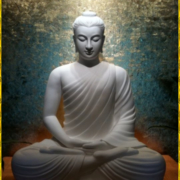11 minute read.
It took 28-days to hike over the Himalaya Mountains. This blog describes people I met, life in the Himalayas, altitude sickness (and rescues), and methods I used to develop mindfulness. It began in the town of Besisahar and ended in Beni Bazar.

Background
This was part of a longer backpacking trip through Nepal and India, where
I arrived in Kathmandu, learned basic Nepali phrases, then traveled through both countries without plans, adapting each day based on people I met and lessons I learned.
PLEASE NOTE: this is an older post, written immediately after arriving home. I’m keeping it here because of links to it, but I’ve rewritten it in another article it to be more genuine. Not that this one isnt’ genuine, it’s just more “factual” rather than personal – I was new to blogging, especially about personal topics. I don’t fully understand what happened to my mind in the briefest of moments after crossing the Himalayas; it was positive, but complex and due to changes in neural connections and consequently my perspective. I suggest using the “search” feature or seeing highlighted blogs to understand that better, for example the article “You get what you give in Varanasis India” that I wrote after a few months of practicing writing more genuine, personallized articles. I’ll probably keep working on more and hope you check back or subscribe for updates every 6-12 months.
Also, a lot happened on this hiking that I can’t begin to summarize in one, two, or a dozen articles – these 28 days of hiking could be a book separate from the 2.5 month trip through Nepal and India.
Added August 2018
I’ve traveled this way for 30 years, flying into one country and out of another, and this trip was a milestone of having visited 1 out of 4 countries in the world. This trip was different because I had a goal to hike without pain medications, developing mindfulness instead. Doctors at the
Veterans Health Administration had prescribed pain medications to me for over nine years to postpone surgeries that have low probabilities of relieving pain. The pain meds treated symptoms, but my mind was sluggish and it was difficult to make wise choices for long-term health. In this blog, I share a few techniques I used to develop mindfulness, hopefully helping someone else find alternatives to opioid pain medications or surgery.
The trail
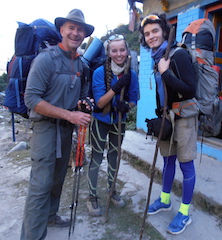
I flew into Kathmandu, learned basic Nepali phrases, and decided to hike across the Himalaya Mountains as part of a longer trip through Nepal and India.
I took a bus from Kathmandu to the village of Besisahar, being dropped where the dirt road ended and a hiking trail began. I had a backpack with two months worth of clothes. I carried a day’s worth of food and water, a few books, a camera, and a Frisbee.

This was the foothills of the Himalayas, an area with thick forests and steep canyons carved by rivers. The trail cut into the sides of mountains, crossing rivers with suspension bridges swinging hundreds of feet in the air. Two people could not pass on the narrow bridges, so we’d coordinate who went first. Goats, cows, and buffalo used the bridges; I gave right-of-way to anything with horns, and played with anything that was cute.




Sleeping & eating
I carried a day’s worth of food an water, knowing I’d find more on the trail. The trail goes through villages, passing people’s front doors. Most families offer simple beds and dinners to travelers. Their ancestors had done the same thing to Tibetan traders for generations.

Clean water was available at filter-stations, installed by the government of New Zealand, which trained villagers to maintain them. This type of investment is called a “
sustainable social business,” providing the infrastructure for local entrepreneurs to earn a profit while benefiting people and the planet. Sustainability is the
triple bottom line: People, Planet, Profit.

Most villages don’t have schools. Some do, and nearby villagers walk the trail for hours to reach them. There are not medical services. Poverty is common, and the area was recovering from a recent civil war that killed 19,000 people and displaced 200,000. Foreign aid doesn’t reach them. Despite these challenges, the Himalayan people are kind, industrious, hard-working, and peaceful. Himalayan people say, “what is there to do?” as a way to be present in the moment and only worry about what is within their control.

Part of what’s in everyone’s control is our kindness towards others. Nepali culture encourages compassion, shown by how kids would run into the street to greet me when I approached a village. They’d clasp their hands, bow, and say “Namaste,” the Hindu word for “I see the divine in you.” I’d clasp my hands, bow, and wait to feel the sentiment before returning the word, “Namaste.”
Feeling compassion and speaking truthfully makes everyone happier. Imagine if our culture encouraged pausing to seek compassion for a person before saying, truthfully, “I hope you’re well.”
The poorest backpacker is wealthier than these kids can imagine, and many share treats. A consequence is a that kids start seeing backpackers, most of whom are caucasian (white), as sources of things rather than as people. They don’t say Namaste, they shout, “Money! Chocolate! Sweet!” You can’t see the divine in each other with a hierarchical relationship, so I gave the most valuable thing I have, time.

Many Himalayan families had been in travelers’ photos, but had never used a camera or seen their own picture. I lent my camera to kids, letting them learn by playing with it. They’d take photos of their parents, show them, and try again with new button combinations. In return, they’d teach me Nepali words for what they saw. This is co-learning, a powerful tool for connecting with students.
Kids took many of these photos, letting us see the world through their eyes.

People

I was hiking uphill each day, gaining 400-500 meters of elevation. Each night got colder; before going to bed, I’d huddle around kitchen fires, learning to cook Himalayan food while talking with families.
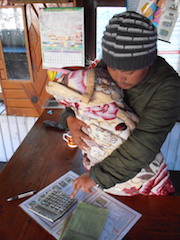
Most guest houses were people’s homes, and they juggled family duties while preparing our dinners. One host, Narme Llama, was a third-generation Tibetan with newborn twins. He had a warm smile, had learned four languages, and helped take care of his new daughters while running his business.
I arrived at the end of season without tourists, so a bed was free. A meal cooked over their wood stove was 200 Rupees ($2 U.S.). Ginger tea was 60 Rupees. They saved money to send their older daughter to boarding school in the nearest city, two-days away, for $15/month. They were lucky to save $2 per month, which would have to support them in old age. There were no schools nearby, and all jobs were physical labor that didn’t need an education, but Narme-Llama valued education. He realized their government wouldn’t build roads, schools, or hospitals in rural areas, but was grateful for his family and the values installed by his grandfather that helped make their exile from Tibet and independence in the Himalayas peaceful, despite being viewed as unwelcome refugees. Images of Buddha were on the walls; the Buddha taught how to seek your own happiness, because no one else can do that for you.

Sometimes a guesthouse would have other backpackers, or travelers with a guide, and we’d share time around a fire learning different perspectives on the world.
Some travelers had smart-phones with translation apps and solar-chargers, allowing us to communicate with almost anyone. Even tiny villages had WiFi; people couldn’t get toilet paper, but could browse the internet. Our world could be moving towards a global democracy, where people solve problems rather than politicians, or we could could be moving towards replacing democracy with “
dataism.” (Read “
Homo Deus.”) Wherever we’re going, 7.6 billion people using smart-phones will get us there faster.

Elevation
I hiked uphill 4 to 8 hours per day. Trees became rare, and snow-capped mountains became common. Tibetan prayer-flags highlighted mountains I’d eventually cross.

At higher elevations, people from poor castes walk downhill to collect firewood each day, walking back uphill to sell it. Tourists use more firewood than the local ecosystem can resupply; to balance this, the government agency overseeing this area has encouraged gas stoves. The alternative was burning yak-dung, which isn’t as smelly as you’d imagine, but I wouldn’t try it at home.
Mules resupply villages with gas tanks and food that can’t be grown in high elevations.

Democracy
Every few days I’d walk into a town, which is larger than a village and serves as a trading center. Towns had comfortable guest houses and supplies for backpackers, such as Snickers candy bars.
In the town of Manang, we had to wait four days because all guest-houses in the region were full of people from Kathmandu, who had traveled to vote in the national election. In Nepal, people must vote in the town they’re registered, usually where their ancestors were born. This was Nepal’s second election; their democracy was new, and followed a ten-year civil war that had divided the people between the poor and wealthy.


Nepali soldiers patrolled the streets of Manang, enforcing a curfew with guns rather than logic. Nepal uses their soldiers as defense, police, and national park protection. Until the civil war, they were the only people with guns, and without checks-and-balances they abuse their power in rural areas. I believe this will change now that Nepal has a democracy; I’ve never had a gun pointed at me in a country with a functional democracy.

The curfew didn’t affect our stay in Manang because there was nothing to do at night, especially when temperatures were below freezing. We’d walk up and down the street then return to our guesthouse to get warm around a yak-dung fire.
The guesthouse where we stayed was decorated for what the owners imagined a typical traveler would enjoy. Their home look like a rustic version of a 1970’s television sitcom; for some reason, they assumed that a typical traveler expected a Tiki bar.
The family had locally-made rice wine, which is served warm. We’d place cups of wine on the stove to keep both us and the wine warm.

We spoke with local families about the election. Most people didn’t understand the differences between political ideologies, they simply hoped for a better life. The communist party overwhelmingly won elections in rural areas. In cities, the status-quo remained. Their new democracy would share government decisions between parties. Regardless of this year’s outcome, it’s a step towards more people having a voice in their future. They celebrated with parties in the street.

Silence
After the elections, I started hiking through remote areas. My head hurt from spinal injuries, my hips hurt from arthritis and inflammation, and the screws in my ankle caused the bones to throb with pain. But I did not experience worry, anxiety, stress, or suffering. I walked silently, concentrating on being mindful.

You see more wildlife when walking silently. Some, like this yak, are not subtle. Others are easily missed; there are at least four mountain goats in this photo:

And at least two in this photo:

Mindfulness is being an observer of your mind and body’s interactions. Mindfulness begins with an intention to be more aware of each moment and how we choose our thoughts and actions. For many people, that’s enough to change their lives. But, people with chronic pain are constantly distracted by signals between their body and mind, so mindfulness requires concentration and practice, like a sport or academic subject that seems difficult at first.
To practice mindful meditation while walking:
Be aware of each moment, but do not become attached to it.Be aware of discomfort, but become detached from it.Be aware of pain, but do not suffer.
Mindfulness is difficult while hiking, especially at high altitudes and with a heavy backpack. Many people practice with 10-minute sessions of meditation, observing thoughts and feelings come and go, then apply the same concentration while walking.
Altitude
Many people do not get altitude sickness. I’m not one of them.
This photo was taken from the window of a shelter, where I stayed for three nights to recover.

For almost a week, I had been hiking at over 3,400 meters (~11,000 feet), gaining 300-500 meters each day. I had a headache and craved oxygen. My body fought two needs: deep breaths to get oxygen vs. tightening my windpipe to keep out the cold, dry air. I have asthma, and my breath “wheezed” on steep sections of the trail.
When you’re emotionally detached from discomfort, you’re able to differentiate between transient discomfort and symptoms of altitude sickness. At 4,880 metres (16,010 ft, ~ 3 miles) I realized that my headaches and dizziness were signs of trouble, so I descended to a shelter at 4,540 meters.

I stayed in a small room with one window that allowed cold wind into the room. I laid awake for hours, trying to stay warm as ice formed in my water bottle. It was -17 degrees by 2am. My heart was pounding at 124 beats per minute, more than twice my normal resting rate. Every muscle in my body was tense, sending blood to vital organs. I couldn’t descend; in daylight, it was six hours down a narrow and dangerous trail to the next shelter. I concentrated on relaxing until my jaw unclenched, which led to my teeth chattering at 124 beats per minute. I had prefered a clenched jaw.
By sunrise, my pulse was down to 80 beats per minute. I didn’t move that day, and by that evening my pulse was ~ 60 beats per minute, still more than my normal resting rate, but reasonable considering I was 3 miles high.

I acclimated by hiking to higher elevations during the day, descending to sleep at night. On one of these hikes, I found an emergency satellite phone. Three years prior, almost 400 people were
trapped at this location by a surprise snowstorm; 42 died, and 175 suffered frostbite. I was not reassured by the satellite phone, which was made from a coffee can and something that looked like the dish-drying rack by my sink at home.
Hiking at high altitude requires focus for each step. Your body is tired from lack of oxygen, and your mind wants to be somewhere else. Hiking above 17,000 feet can require 10 to 15 seconds of focus per step.

I had been focused on each step for six hours when I saw a tea shop.
Seriously.
A cheerful entrepreneur had brought gas stoves and tea to a shelter at 17,900 feet. I paid $1.50 for a cup of hot tea; I would have paid a hundred.
Over the next few hours, his hut saved someone’s life.

I reached the summit, sat down, then got up as I realized something was wrong with one of the four other people. She was suffering severe altitude sickness. Her eyes were rolled back into her head, her breathing was in brief gasps, and her pulse was more than 150 beats per minute. She was in shock, and it was likely that pressure was building insider her brain.
None of us spoke the same language; we carried her into the tea hut while her guide was trying a satellite phone to call help. Over the next few hours, we kept her warm in the tea shop while preparing a helicopter landing zone. We carried her and her bags onto the helicopter, which would prioritize getting her to a lower elevation, and then to a hospital.


The helicopter cost $10,000. It was a private service, and the patient’s guide received a commission for calling it. The tea shop entrepreneur made $1.50. Three years ago, when the storm trapped 500 people here, local people dug through snow without concern for how they would get paid. There’s no right or wrong, just facts. Mindfulness is being aware of facts, but differing judgement until those facts are necessary to make a decision.
When the helicopter left, I was alone again. I started walking down the other side of the pass.
Mindfulness
I had been so focused on the rescue that I hadn’t felt pain or symptoms of altitude sickness. I started to notice the pain again. Descending steep trails is harder on your joints than hiking uphill, and my head and joints screamed with pain. People become addicted to temporary relief from pain, either from medications or work, so more doctors are recommending mindfulness to reduce suffering.
I practiced mindful meditation with each step. When I had descended enough to reduce the effects of altitude sickness, I stopped to eat a Snickers candy bar. It was the first food I could hold down in 24 hours; at that moment was the most delicious thing I had ever eaten. In the time it took for my teeth to break through a peanut, all discomfort faded. I had no thoughts, just awareness. The sky was brighter, the air cleaner, rocks more beautiful than before I began taking that bite. All that needed to be done was done. I was seeing things how they really are. This experience lasted for a month, and, to a lesser extent, remains now that I’m home.
Pairs of neurons in my brain had become detached, separating physical pain from mental suffering, allowing me to see more clearly. A month later, I’d learn more about this phenomenon from experts on meditation and neuroscience at a conference on “
Mind and Modern Science.” At the conference, the
Dalai Lama emphasized that understanding how our minds work allows us to make wiser choices that benefit ourselves and others. I had read research about this, and had heard testimonials from other people, but to experience it for oneself removes all doubt.
I walked downhill for a few more hours, found a guest house, and enjoyed the sunset. Two days later, I started hiking off-the-beaten-path.

Continue to:
Or, jump forward two weeks:


















